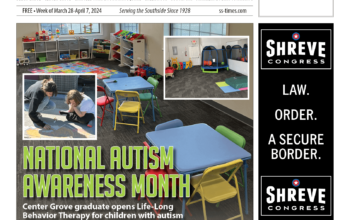By Angela Norris
A historic Greenwood home will have a future as an event center.
The Mills House, sitting on just under four acres of forested landscape on Fry Road, was empty for nearly four years and in dire need of repairs.
The Wrightian style house is a preeminent Mid-century modern landmark. Years of neglect produced a collapsed, flat roof with overhanging eaves, mold and termites; wildlife was growing inside.
The historic house made Indiana Landmarks’ 10 Most Endangered list in 2015. Eventually, the home captured the attention of a Greenwood businessman, Todd Anthony, who purchased the home late last year. Anthony saw past the decay to see plans for a future.
“Having grown up in Greenwood like so many others, I was saddened to see this Greenwood landmark fall into such a state of disrepair,” he said. “When I first toured the home, it immediately reminded me of a business event I attended at Frank Sinatra’s Twin Palms home in Palm Springs, California. And, while Greenwood is well served with event centers, it lacks a space that it dedicated to intimate upscale business events. In addition to hosting regular business members, I hope to have the home open for tours, charity events and for fundraising.”

The Mills House was named after its original owner, Ernie Mills, and built in 1955 by a famous Hoosier architect named Harry Cooler, who studied under Frank Lloyd Wright. Cooler owned a store in Indianapolis that sold kitchen and bathroom cabinetry and Formica countertops. The Mills House was one of Cooler’s first projects. The exterior featured a front porch patio and fieldstone knee walls. The house blurred the distinction between indoors and outdoors with floor to ceiling glass.
The interior featured original woodwork, including kitchen cabinets, trim and paneled walls. The original terrazzo floors were a distinct feature. The fieldstone chimney was the central feature of the living room.
“I saw the renovation in January, and it was amazing to hear the stories and hear the plans,” said Suzanne Huntzinger, who wrote about Mills House. “Since then, the work has been mostly demo work. They’re waiting on electricians before they move to the next step.”
“As far as the renovation, we are on schedule for a fall opening and are nearing the completion of our initial phase, which has consisted of stabilizing the property to prevent further damage,” Anthony added. “We have removed dead trees that were threatening the home, abated the wildlife living inside, removed dangerous electrical items and installed a temporary roof. We have successfully replaced the joists that hold up the cantilevered roof and removed the temporary jacks returning the home to its original style.
“Next up will be sending all the interior woodwork offsite to be refinished and replacing the HVAC and plumbing. In the next few weeks, weather permitting, we will be installing a permanent roof and trim around the upper soffits. Additionally, I have started to collect some period appropriate furnishings to complete the home. One of the highlights will be a Frank Lloyd Wright conference table and chairs, which I purchased and had delivered to Greenwood recently from its original location in The Netherlands.”
Anthony plans to work with Cooler’s son, Bill, also an architect, to restore and renovate Mills House.
For updates on progress, please visit the Historic Mills House Facebook page.

